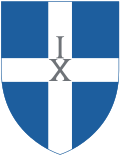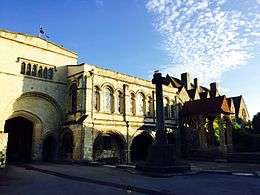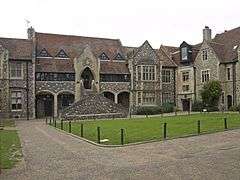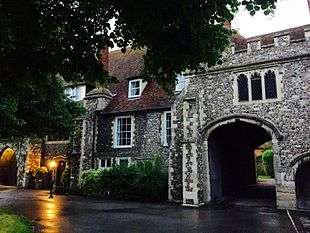The King's School, Canterbury
The King's School is a 13–18 mixed, independent, boarding and day school in Canterbury, Kent, England. It is a member of the Headmasters' and Headmistresses' Conference and the Eton Group. It is Britain's oldest public school; and is arguably the oldest continuously operating school in the world, having been founded in AD 597.[lower-alpha 1]
| The King's School | |
|---|---|
 | |
| Address | |
25 The Precincts , , CT1 2ES England | |
| Coordinates | 51.281671°N 1.082710°E |
| Information | |
| Type | Public school Independent, boarding and day school Cathedral school |
| Religious affiliation(s) | Church of England |
| Established | 597 |
| Founder | Augustine of Canterbury |
| Local authority | Kent County Council |
| Department for Education URN | 118996 Tables |
| Chairman of Governors | Robert Willis (Dean of Canterbury) |
| Headmaster | Peter Roberts |
| Chaplain | Rev Lindsay Collins |
| Gender | Mixed |
| Age range | 13–18 |
| Enrolment | 860[1] (2018) |
| Capacity | 910[1] |
| Houses | 16 |
| Colour(s) | Blue and white |
| Affiliations | |
| Alumni | Old King's Scholars |
| Website | www |
History

The school originated as a medieval cathedral school said to have been founded during the Late Antiquity in 597 AD, a century after the Fall of the Western Roman Empire, by Augustine of Canterbury, considered the "Apostle to the English" and a founder of the English Church, therefore making it arguably the world's oldest extant school. This is based on the fact that St Augustine founded an abbey (within the current school's grounds) where it is known that teaching took place.[2]
When the Dissolution of the Monasteries took place, the School was re-founded by royal charter in 1541. A Headmaster, a Lower Master, and fifty King's Scholars were established and the name "King's School", was used for the first time, referring to King Henry VIII. Cardinal Pole moved the school to the Mint Yard and acquired the Almonry building, which was in use for over 300 years.
Throughout the next 100 years, a number of former pupils achieved national recognition, helping the school to establish its reputation; these include the first Headmaster, John Twyne, as well as Christopher Marlowe, William Harvey and John Tradescant the Younger. The buildings were improved and academic standards raised during the leadership of John Mitchinson, and around this period, the School became a "public school" with a national reputation.[2]
When Canon John “Fred” Shirley became Headmaster in 1935, the School was suffering from the effects of the depression, and he saw the School expanded greatly to around 600 pupils in some 30 years. He constructed further buildings in the Precincts, as well as helped the School to survive the war-time evacuation, and the School received a new Royal Charter from King George VI and Queen Elizabeth in 1946. During this time, the reputation of the School grew, helped by its academic and sporting successes.
The school was boys-only for almost 1,400 years, until the early 1970s, when girls were admitted to the Sixth Form for the first time, and the School has been fully co-educational since 1990.[2] The school is also the oldest charity in the UK.[3]
Assessment
In 2017, the school was subject to its latest regular, independent inspection.[4] The inspection team praised the "outstanding academic results" and the pupils' integrity, self-assurance, and "generosity of spirit". According to the Good Schools Guide, the school is "Highly successful, producing excellent results". The Guide also stated that "You need to be creative, academically able and hard-working, as everything moves fast here."[5]
Houses
There are 16 houses at King's, 13 boarding and 3 day.[6] Most are named after past headmasters or people of interest in the school's history, with the exception of School House, The Grange and Carlyon. The Houses of the School are:
- School House: founded 1860 (boys boarding)
- The Grange: founded 1928, moved to a new building in 2007 (boys boarding)
- Walpole: founded 1935, (girls boarding). Named after the novelist Sir Hugh Walpole (KS 1896–98)
- Meister Omers: founded 1936, (boys boarding).
- Marlowe: founded 1936, (mixed day). Named after the poet and dramatist Christopher Marlowe (KS 1579–81)
- Luxmoore: founded 1945, (girls boarding). Named after Sir Arthur Fairfax Coryndon Luxmoore (KS 1889–93), Lord Justice of Appeal
- Galpin's: founded 1952, (boys boarding). Named after The Reverend Arthur Galpin, Headmaster from 1897–1910.
- Linacre: founded 1953, (boys boarding). Named after Thomas Linacre, founder of the Royal College of Physicians
- Broughton: founded 1976, (girls boarding). Named after William Broughton (KS 1797–1804), the first Bishop of Australia
- Tradescant: founded 1976, (boys boarding). Named after John Tradescant (KS 1619–23), the distinguished gardener and collector.
- Mitchinson's: founded 1982, (mixed day). Named after John Mitchinson, Headmaster 1859–73 and co-founder of the Headmasters' Conference.
- Jervis: founded 1992, (girls boarding). Named after Douglas Jervis OKS
- Harvey: founded 1996, (girls boarding). Named after William Harvey physician, who first determined the systemic circulation of the blood (KS 1588–92)
- Bailey: first founded 1990, (sixth form girls boarding). Named after Henry Bailey, second warden of St Augustine's College between 1850 and 1875 and an honorary Canon of the Cathedral
- Carlyon: founded 2005, (mixed day). Named after evacuation of the School to Carlyon Bay in Cornwall during the Second World War
- Lady Kingsdown House: founded 2015, (girls boarding). Named after Lady Kingsdown, Governor Emerita
Facilities


- The Beerling Hall Music and Drama Facility, part of the 13th-century friary, endowed by the late Donald Beerling and the Cantiacorum Trust
- Birleys Playing Fields The School's sports grounds, located near the main site. A new pavilion was opened by David Gower on 17 September 2005
- Blackfriars The Cleary Foundation donated the refectory of the 13th-century friary by the Marlowe Theatre as an art school and gallery.
- DT Centre Design Technology & Engineering
- Edred Wright Music School Music
- Field Classrooms English and Mathematics
- Grange Classrooms Mathematics, Religious Studies
- Harvey Science Block or Parry Hall Biology, Chemistry
- J Block Geography
- Lardergate History and OKS Foundation
- Lattergate Religious Studies and Headmaster's office
 The Shirley Hall was built on the site of the tennis courts and opened by the Queen Mother in 1957. Assemblies, plays, concerts and public examinations all take place here. Underneath the Hall is the Pupils’ Social Centre
The Shirley Hall was built on the site of the tennis courts and opened by the Queen Mother in 1957. Assemblies, plays, concerts and public examinations all take place here. Underneath the Hall is the Pupils’ Social Centre - The Malthouse Victorian malthouse building now converted into a theatre, dance studio, dining hall, classrooms and rehearsal spaces
- Maurice Milner Memorial Hall Fencing, Drama and Examination Hall
- Mint Yard Classrooms Mathematics, ICT
- The New Classrooms, three new classrooms built in 2017 in front of Shirley Hall. They are temporary buildings situated in a previously open space.
- The Old Synagogue at Canterbury Music, Jewish Prayers. Built as a synagogue in 1847–8 by architect Hezekiah Marshall, the "Old Synagogue" is used as a recital hall by the music department and also used to host "Jewish Society". It is considered one of the finest buildings of the 19th century Egyptian Revival style.[7]
- Palace Block a medieval building containing the Modern Languages Department
- Physics Block Physics, Geology
- Pottery Room Pottery
- Priory Block Classics, English, Politics, Economics
- The Pupils' Social Centre under Shirley Hall with a tuckshop, cafe, stationery Shop and Careers Centre
- The Recreation Centre Gym, Hockey Pitches, Swimming Pool, etc. It is open to the general public on a membership basis.
- The School Library (contains over 25,000 volumes and offers access to the School Intranet)
- Shirley Hall School Assemblies and Examination Hall; formerly known as the Great Hall, renamed after the former headmaster, Fred Shirley
- St. Mary's Hall Drama, Theatre Studies
- The Westbere Lakes Sailing and Rowing
Traditions
King's has many traditions including:

- Full Canterbury Dress: The name given to the school uniform, which consists of a white shirt with wing collar, black waistcoat, pinstripe trousers, black jacket, black socks, black tie and black shoes for the boys. Girls wear a white blouse, brooch, pinstripe skirt, black jacket, black tights and black shoes. When he came to the School, Fred Shirley, Headmaster (1935–1962), updated the school uniform to sports jackets. But within a year, the boys had asked to revert to their traditional garb. He tried again after the War when the School returned to Canterbury, this time taking a vote on the matter. But despite the difficulty in finding outmoded clothing in a time of clothes rationing, the boys once again decided to revert to tradition. In the mid-twentieth century, there were elaborate customs relating to such matters as buttons and the angle at which a boater was worn. The girls' version was introduced by Anthony Phillips, Headmaster.
- Court Dress: Worn on 'Commem Day', the last day of the school year, leavers wear court dress, consisting of white tie and black evening tailcoats, with breeches and black stockings. Purples wear their purple gowns and carry brown canes with gold handles while the Organ Scholars of the school wear black academic gowns over their court dress and carry black canes with Silver Handles.
- School Song: In the late nineteenth and early twentieth centuries Harrow's ‘Forty Years On’ was often used. It was sung at concerts and penny readings. In 1914, two OKS – Henry Morice and Bertram Latter – composed their own offering entitled ‘The School of Theodore’. This concentrated on the School's antiquity. Theodore, Archbishop of Canterbury (668-90), was widely regarded as the founder of the King's School's ancestor school. The song was popular for a short time.
- Colours Jumpers: Students who have been awarded full school colours in any sport are entitled to wear a white and blue cricket jumper instead of a regulation school black jumper. Those who receive 1st team colours are entitled to wear a special tie. More recently there has been the addition of the co-curricular colours for those excelling in drama, music and the arts. Recipients are entitled to wear a jumper with a maroon stripe.
- Purples: Until recently called 'monitors', these are the school prefects, who are marked out by their distinctive purple gowns. Only those in the highest year at the school may be a purple. Each house generally has one purple (the Head of House). The purples are headed by the Captain of School and a Vice-Captain. A head scholar and two Vice-head scholars are also invited to become purples.
- The Goat on the Green Court: Something of a legend among pupils, the Captain of School is allegedly allowed to keep a goat on the large lawn in the centre of the school. This particular tradition is no longer practised. The Captain of School is also allowed to grow a beard and take his wife to lessons.
- King's Scholars: An academically-select group, marked by black jumpers with white trimmings that have recently replaced their distinctive black gowns, they process wearing surplices during school services in the Cathedral. To become a scholar, a pupil must take the Scholarship examinations at a standard approaching GCSEs prior to entry at the age of 12 to 14 (Exhibitioners may also be elected) or, in the case of honorary scholars, achieve exceptional GCSE results (9 A*s is usually the minimum) or AS Level results. King's Scholars are part of the Canterbury Cathedral Foundation and have a role in the Enthronement of the Archbishop of Canterbury. Scholars are admitted by the dean at the beginning of every school term; the scholars kneeling before the dean, who then touches their head and utters ‘Admitto Te’, formally acknowledging them as a King's Scholar.
- Gatings: Uniform Gating: A form of punishment that requires pupils to wear Canterbury Dress all day every day, while getting a form signed by someone in a position of authority (usually a teacher or a purple) at 15-minute intervals during their free time. This can prevent them from leaving the school at all for up to a week.
- Breakfast Gating: A form of punishment by which the pupil must report to breakfast and get a special slip, called a gating slip, signed at 7:30.
- Supper Leave/Pub Leave: A recent privilege extended to Sixth Formers, whereby pre-approved groups of people may go into town for supper or visit a pub for one night.
- The House Shout: Two shouting competitions. One takes place between The Grange and School House which, until the building of Mitchinson's House, were opposite each other. Held on the last day of each term. Members of the Grange would assemble outside Lattergate House (later renamed Algy's) from where School House is visible and call out the House Shout from that vantage point. School House would then come out and the Purple of Galpin's would adjudicate the victor on wittiness, clarity, volume and house spirit.[5] This tradition has not been held in recent years, although every year after the inter-house song competition, Galpin's House and School House have a similar, non adjudicated shouting match, with more emphasis on volume than anything else, often including the chant "you're not singing any more". The second House Shout takes place between Linacre and Meister Omers, and is an annual tradition that is not adjudicated.
- Good Morning Assembly Calls: A tradition whereby if two people were considered in a relationship with each other, the respective boy's house would call out at the end of assembly 'good morning' to both partners in the relationship, by their surnames. For example, 'Good morning Smith, good morning Jones'. It has since been discouraged by senior staff.
- Monitors' Canes: A privilege given to School Monitors (Purples) and House Monitors. Purples are allowed black canes and House monitors are allowed wood coloured canes. The Head of the CCF is also allowed to carry a pace stick.
- Younger Purples: A tradition in which a certain member of each house (traditionally the shortest person is chosen) are given the purple gown on days when it is a charity non-uniform day. This allows the designated person to exercise the rights of the Purples.
- Green Court Privilege: Only those in 6a (the final year) are allowed to walk across Green Court; everyone else must walk around it.
- Mint Yard Privilege: Only those in Galpin's and School House are allowed to walk on the Mint Yard Lawn during the Summer term
- Walpole Carnations: The Valentine's Day celebrations, organized by the girls of Walpole house. Pupils send a carnation with an anonymous message to a friend or lover.

King's Week
A festival of arts, held during the last week of the summer term, introduced by Fred Shirley in 1952.[8] The week features over 100 events, ranging from classical concerts to theatre performances, held in a multitude of locations around Canterbury. Many of the events are free to attend and require no booking and a number are broadcast live.[9]
The week culminates in Commemoration day (known as "Commem") on the last day of the school year when the school leavers in 6a wear court dress of white tie and tails, with breeches and black stockings, or their national dress, and the whole school attends a service to commemorate the school benefactors. Monitors also wear their gowns and can carry walking canes, or 'swagger sticks'.
Office of Fair Trading investigation
In 2005, the Office of Fair Trading (OFT) provisionally found that the school exchanged detailed information about prospective fee increases with approximately 50 other prominent UK independent schools, including Eton and Sevenoaks.[10] The OFT stated that "regular and systematic exchange of confidential information as to intended fee increases was anti-competitive and resulted in parents being charged higher fees than would otherwise have been the case."
Notable alumni
The Junior King's School, Canterbury
The King's School also has a feeder preparatory school, the Junior King's School (JKS), previously Milner Court Preparatory School. The school is a coeducational boarding and day establishment and currently has around 400 pupils aged 3 to 13. Whilst there are boarding facilities available, the majority are day pupils. JKS is now located at Milner Court in Sturry, having been originally based in the crypt of Canterbury Cathedral.
The current site was donated by Lady Milner following the death of Alfred Milner, 1st Viscount Milner in 1925. The buildings on site were opened by Rudyard Kipling in 1929, in his capacity as a close friend of Alfred Milner.[11] Wilfrid Oldaker was headmaster from 1945 to 1956 and was the last head to occupy the manor house as the headmaster's residence.[12] Further extensions include a sports hall (1999), a CDT block (1991) and a new music department (2016).
The King's School Shenzhen International
The King’s School will open its first overseas branch in the Nanshan district of Shenzhen, China in 2019. The school will blend The King's School's tradition of education with modern purpose, with design by award-winning London based architects, Walters & Cohen. The new campus will be launched in two separate phases. The Pre-Prep section for children aged 3 – 6 will open in Autumn 2019, and the Main School, which will include the Junior and Senior sections for children aged 6–18, will open the following year in 2020.
See also
- List of the oldest schools in the United Kingdom
- List of the oldest schools in the world
- List of Victoria Crosses by school
References
Footnotes
- Shishi Middle School in China claims a foundation c.142 BC but this is disputed owing to a gap in its functioning.
Citations
- "The King's School Canterbury". Get information about schools. GOV.UK. Retrieved 13 January 2019.
- "History of the School". The King's School, Canterbury. Retrieved 27 July 2019.
- "House of Commons - The role of the Charity Commission and "public benefit": Post-legislative scrutiny of the Charities Act 2006 - Public Administration Committee". publications.parliament.uk. Retrieved 27 July 2019.
- "Archived copy" (PDF). Archived (PDF) from the original on 6 April 2018. Retrieved 6 April 2018.CS1 maint: archived copy as title (link).
- Good Schools Guide Archived 2009-02-10 at the Wayback Machine.
- "Page not found". The King's School, Canterbury. Archived from the original on 8 December 2014. Retrieved 5 April 2018.
- Kadish, Sharman (2002). "Constructing Identity: Anglo-Jewry and Synagogue Architecture". Architectural History. SAHGB Publications. 45: 386–408. doi:10.2307/1568790. JSTOR 1568790.
- "King's Week Arts Festival". The King's School, Canterbury. Retrieved 27 July 2019.
- "King's Week 2019 gets underway". The King's School, Canterbury. 27 June 2019. Retrieved 27 July 2019.
- Press release Archived 2005-12-07 at the Wayback Machine, Office of Fair Trading, UK, 9 November 2005.
- http://www.junior-kings.co.uk/pages/newsEvents/pages/80thAnniversary/docs/kiplingProgramme.pdf%5B%5D
- David Lawrence Edwards, A History of the King's School, Canterbury (Faber & Faber, 1957), pp. 172, 205
External links
| Wikimedia Commons has media related to Kings School, Canterbury. |